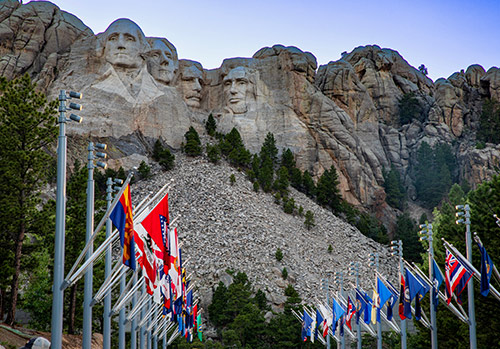
Photograph by Mick Haupt on Pexels.
You probably know your home state flag, or at least you would recognize it if you saw it. If you live anywhere in the nation long enough, you will see a state flag regularly outside schools, post offices, and other places around town. An intriguing history remains behind many state flags. Let us look at five state flags with fascinating stories.
Alaska’s Contest-Winning State Flag
The 49th state to enter the union has a unique flag origin story. In 1926, Alaska’s territorial governor diligently worked to get statehood for Alaska. After seeing the other 48 flags waving marvelously outside the old post office building in Washington D.C., Governor George Parks was inspired and called for a contest among the Alaskan youth to see who could assemble the best flag design. Benny Benson, 13, an orphan from the small Alaskan village of Chignik, created a simple yet impactful design to claim the contest victory. His submitted work beat out 141 other designs. He explained his winning entry as follows: “The blue field is for the Alaska sky and the forget-me-not, an Alaska flower. The North Star is for the future of the state of Alaska, the most northerly in the Union. The dipper is for the Great Bear – symbolizing strenth (sic).” The young man saw his flag flying for the first time on July 9, 1927, earned a $1,000 education scholarship, and received a watch with his flag emblem.
Ohio’s Uniquely Shaped State Flag
The single-state flag that does not have a rectangular shape belongs to Ohio. The swallow-tailed flag displays five total red and white stripes, with a blue hoist triangle that carries a thick, white-bordered red circle and 17 stars. This design is also called a burgee and flown on recreational boats. John Eisenmann drew the flag and established symbolism throughout his creation. Eisenmann declared that the triangle represented Ohio’s hills and valleys while the stripes symbolized the roads and waterways. The red circle enclosed by a white border signifies the first ‘O’ in Ohio and suggests the state’s nickname, the Buckeye State. The thirteen stars engulfing the circle represent the original 13 states, and four additional stars illustrate Ohio entering into the union as the 17th state. Ohio’s legislature adopted the unique flag on May 9, 1902.
Hawaii State Flag Tribute
The Aloha State flag bears a resemblance to Great Britain’s flag and the American flag. Before becoming a state, Hawaii was an independent kingdom. In 1793, Captain George Vancouver gave King Kamehameha I their Union Jack flag as a gift of friendship. The British flag remained the unofficial Hawaiian kingdom flag until the British battled the Americans in the War of 1812. During the war, the king hoisted an American flag at his home to satisfy American interests. It did not fly very long because British officers in the king’s court opposed the flag change. After a brief British occupation in 1843, island officials designed a flag to acknowledge both nations. The stripes allude to Old Glory but also represent the eight Hawaiian islands. In the canton, top left corner, or upper hoist resides the British Union Jack.
South Dakota, the Sunshine State
In 1970, Florida officially adopted the Sunshine State nickname at the approval of its state legislature. Florida has held this moniker for the last five-plus decades. Did you know another state once claimed the Sunshine State nickname? South Dakota’s first state flag was created in 1909, and it consisted of two sides. The first side displayed a dark blue background with the words South Dakota and The Sunshine State surrounding the sun. The opposite side held the state seal. By 1963, it became too expensive to print a double-sided flag. South Dakota’s state government decided the state seal would sit on top of the sun with only the sun rays peeking out from behind the seal. In 1992, legislators switched the Sunshine State nickname on the flag with a new nickname, The Mount Rushmore State.
Oregon’s Two-Sided Flag
Did you know Oregon boasts the only current two-sided flag? The front side displays a golden-yellow state seal on a deep blue background. On the reverse side, a golden-yellow beaver rests on a log against a solid blue backdrop. Several other states formerly had a two-sided flag. As previously mentioned, South Dakota had a double-sided flag for 54 years. For 63 years, Massachusetts hoisted a flag with a coat of arms opposite a pine tree on a blue shield. The state relinquished the pine tree portion in 1971. West Virginia also had a double-sided flag that underwent a few changes early in the 20th century. Both obverse and reverse sides were essentially merged into one image in 1929 with a coat of arms, flowers, and a scroll reading: State of West Virginia, upon a white background and blue border.
If you enjoyed these facts about state flags, please check out another intriguing article about the state of Jefferson.
Life Insurance Questions?
We hope that these stories on state flags are interesting to you.
If you’d like to learn how we can help you plan your retirement, call Empower Brokerage at (888) 539-1633 to speak to one of our Life and Annuity experts or leave a comment down below.
Get affordable life insurance quotes by clicking here.
See our other websites:

